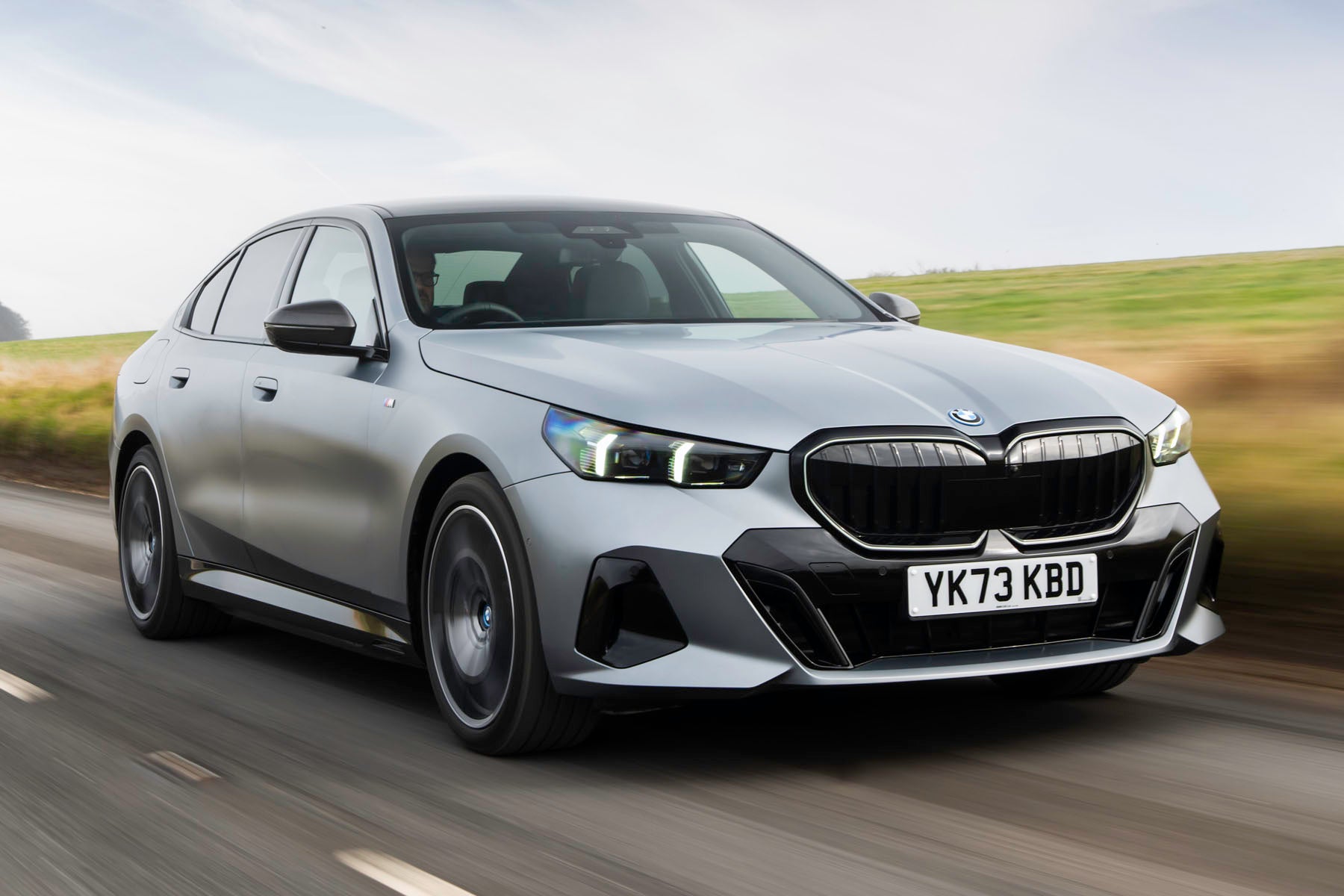BMW 5 Series Review 2025: Price, specs & boot space
Written by Ivan Aistrop
Quick overview
Pros
- Sumptuously trimmed interior
- Lots of space and kit
- Comfortable and enjoyable to drive on adaptive suspension
Cons
- We still don’t know what it’s like on standard suspension
- BMW loves a gimmick these days
- Not enough physical switches inside
Overall verdict on the BMW 5 Series
"Having been first introduced in 1972 and with huge success ever since, the BMW 5 Series is a behemoth in motoring circles. This latest eighth-generation version has had to diversify to stay relevant, but BMW has absolutely nailed its transformation, and come up with a truly stunning executive car."
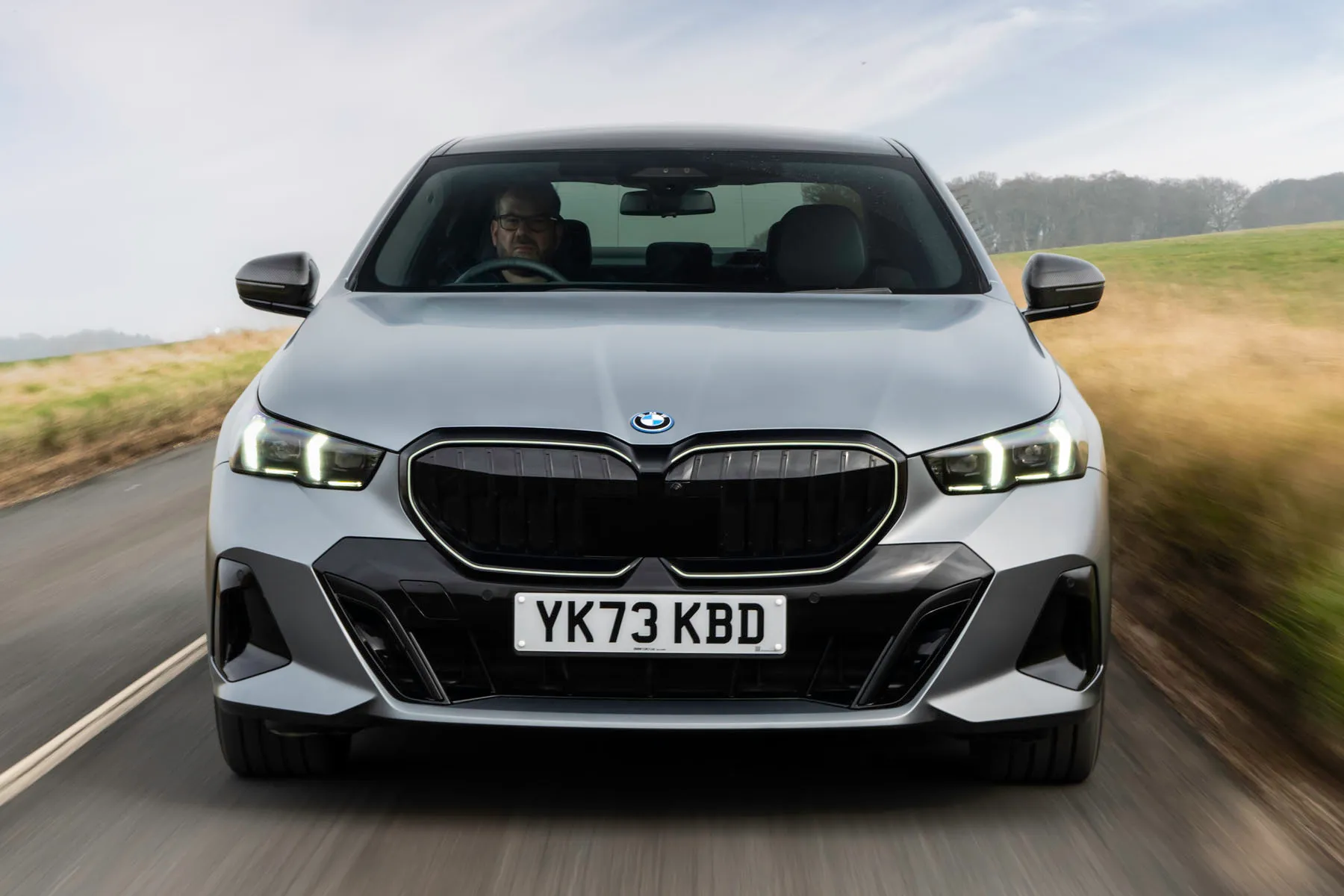
SUVs might be taking over as the models of choice for today’s family car and executive car drivers, but that doesn’t mean that the 5 Series isn’t a big deal for BMW. Huge, in fact. The Bavarian firm’s big executive saloon has been massively successful since it was first introduced in 1972, and this latest iteration is the eighth-generation version. We reckon it’s the best yet, and you can find out why by reading our 2024 BMW 5 Series review.
Of course, the 5 Series has had to diversify in order to stay relevant. The latest 5 Series range includes the BMW i5 models, a trio of all-electric variants that future-proof BMW’s product offering in the midst of the car industry’s relentless march towards an all-electric future, and very good those models are, too. However, we’ve reviewed those independently, so here, we’re concentrating solely on the combustion-engined versions of the car.
And at present, there are three of them. The first is the 520i that uses a turbocharged 2.0-litre four-cylinder petrol engine with mild hybrid technology to develop a combined 208PS, while the other two are plug-in hybrids. The 530e combines the 520i’s petrol engine and an electric motor to develop 299PS, while the 550e combines its electric propulsion with a 3.0-litre six-cylinder petrol engine to give a prodigious 489PS.
Two trim levels are available currently, the M Sport and the M Sport Pro. Both come well equipped with luxury, safety and infotainment kit as standard, while the difference between the two trims amounts to little more than some exterior styling changes, plus the small matter of about three grand. Frankly, we’d save the cash, or spend it on one of the various option packs available instead.
Our experience of driving the latest 5 Series suggests that it delivers just the right blend of agility, comfort, performance and refinement that buyers will expect from this kind of car. However, we’ve so far only had the opportunity to sample high-spec examples with more power and clever suspension technology than more humble versions, so we can’t yet vouch for the abilities of those versions. The ones we’ve tried are truly immense, though.
The other thing buyers will expect is plenty of interior space, good all-round practicality and a sumptuous, high-grade interior. Rest assured, the latest 5 Series has all those boxes checked, and in some style.
Of course, the 5 Series is reassuringly expensive, but we reckon it feels worth the cash, and the efficient powertrains have the potential to keep running costs low. Still want that SUV?
Looking for a used car for sale? We've got 100s of BMW Approved Used Cars for Sale for you to choose from, including a wide range of BMW 5 Series cars for sale. If you're looking for the older version, you need our BMW 5 Series (2017-2024) review.
Is the BMW 5 Series right for you?
Traditionally, the large executive saloon car class has been a very hard-fought one, bitterly contested by the ‘Big Three’ premium German manufacturers in the shape of Audi, BMW and Mercedes. However, the latest 5 Series is so good that we can now see clear daylight between it and its competitors. If you’re after a large executive car with lots of space, plentiful luxury equipment, sensational build quality and a fun-but-comfortable driving experience, then the BMW 5 Series will suit you don to the ground.
What’s the best BMW 5 Series model/engine to choose?
At the moment, we’ve only had the chance to try the range topping BMW 5 Series, the 550e M Sport Pro, with its powerful plug-in hybrid powertrain and sophisticated adaptive suspension. It’s fantastic, sure enough, but it’s also very hard to justify when it costs you £77,000, and that’s before you’ve added any of the myriad optional extras available.
We suspect the sweet spot will lie further down the range, with either the 520i mild hybrid or the 530e PHEV, but we can’t be absolutely sure until we’ve experienced these versions for ourselves. We’ll update this review as soon as we have.
What other cars are similar to the BMW 5 Series?
While the unwavering rise of the family SUV means that there are fewer executive saloons like the BMW 5 Series than there used to be, there are still a few that are clinging on to their existence. The Audi A6 is just such a car, as is the Mercedes-Benz E-Class. If you’re not a fan of German cars, then Jaguar will still sell you an XF, while Lexus might tempt you with the ES.
Comfort and design: BMW 5 Series interior
"With cutting-edge tech, generous interior space, sumptuous materials and a level of build quality that’s simply beyond reproach, the 5 Series’ cabin is simply sensational. Only a few ergonomic irritations let it down."
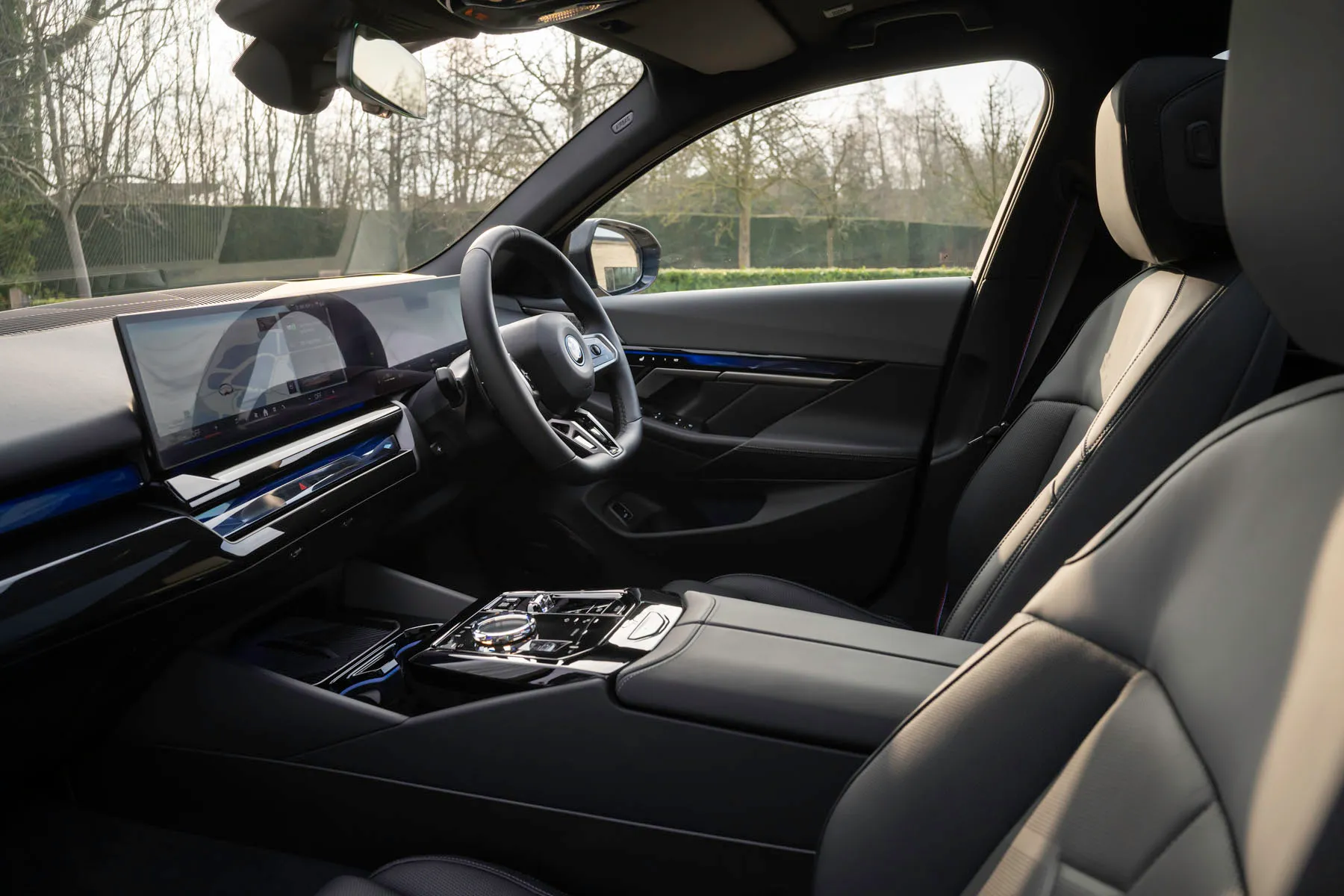
As usually happens with premium carmakers, some tech that made its debut in the 7 Series limousine has now trickled down to the latest 5 Series, and that includes what BMW calls the Interaction Bar. This is a horizontal trim strip that runs the full width of the dashboard and partly into the door trims. Its purpose is twofold: it provides ambient lighting that reflects the activity of the car or the driving mode you’ve selected, and it also houses a number of touch-sensitive controls to operate various functions, many of which are peripheral functions of the ventilation system. It’s an unique feature that’s interesting, if a little gimmicky, but we can’t help feeling that it’s yet another tactic that BMW is using to rid its cars of proper physical buttons and switches - indeed, there are very few left in the 5 Series. And yes, touchscreens and touch-sensitive Interaction Bars might look cool, but when it comes to ease-of-use, we reckon there’s no substitute for traditional controls.
On a more positive note, the driving position in the 5 Series is spot-on, and has plenty of adjustment to help you get comfy, while your all-round visibility is reasonably clear.
Quality and finish
You’d expect any BMW product - especially one as big and expensive as the 5 Series - to provide an interior environment with the appropriate level of luxury. The latest Five does exactly that, and in spades. Every single one of the materials and surfaces you encounter are a delight for both the eyes and the fingertips, and there’s a really tasteful and pleasant mix of textures and finishes. The various switches and knobs work with a satisfyingly clicky precision, too, and the general standard of assembly is top-drawer. You certainly won’t feel like a second-class citizen in the 5 Series.
Infotainment: Touchscreen, USB, nav and stereo in the BMW 5 Series
All versions of the 5 Series get the same infotainment system, which brings together a 14.9-inch central screen and a 12.3-inch instrument display, both housed together in a curved single-piece unit. The arrangement looks very swish, with a glossy finish and sharp, modern graphics.
As we said a bit earlier, with BMW being seemingly desperate to rid its cabins of switches and buttons, most functions are now operated through the central screen. The system also supports the important entertainment and information functionality that customers will demand, including DAB, a harman kardon surround sound audio system, Bluetooth, wifi, navigation, Apple CarPlay and Android Auto, wireless phone charging, numerous USB points (two front, two rear) and remote software upgrades.
Like most such systems, the central screen has touchscreen capability, but it can also be operated - thank heavens - by turning and pressing a rotary controller on the centre console. This is far less distracting to use on the move. There’s also a handful of shortcut buttons placed next to the dial, plus additional shortcut icons running across the bottom of the screen, and these all provide quicker and easier access to the car’s most-used functions. Useability could be considerably worse, then, but the system still takes quite a bit of getting used to, purely by virtue of how complicated it is.
Space and practicality: BMW 5 Series boot space
As a large executive saloon, the BMW 5 Series is a big car: to be precise, it’s 5060mm long, 1600mm wide, and 1515mm tall, with a wheelbase (the distance between the front and rear wheels) of 2995mm.
You’d expect any car of this size and type to be able to transport numerous adult passengers in comfort, and the 5 Series most certainly obliges. Even with the front seats set up for occupants of six feet tall or more, the rear seats still have legroom that’s generous enough for a passenger of the same size to stretch out comfortably, while headroom is also more than adequate for lofty adults.
Just make sure you don’t try to carry too many people at once. The rear bench is very comfortable indeed for two people, but try to squeeze a third in, and nobody will be particularly comfortable because the cabin is too narrow for three sets of shoulders. You can live with it on short hops, but you wouldn’t want to travel five-up for any significant length of time. The middle seat is also harder and narrower than those either side, and the transmission tunnel in the rear floor limits how much foot space there is.
While many plug-in hybrid cars lose boot capacity compared with their pure-petrol counterparts, the 5 Series provides you with a large 520-litre loadspace regardless of which version you pick. The i5, meanwhile, gets a little less with 490 litres.
Of course, the saloon-car bootlid means that access to the space isn’t as good as with a hatchback, and it also means that the space itself is rather shallow. Still, if that’s a problem for you, you can always go for the BMW 5 Series Touring estate car version instead of the saloon. At least you get versatile 40-20-40 split-folding rear seats as standard, but again, the aperture between the boot and passenger compartment is shallow and oddly shaped in the saloon.
Handling and ride quality: What is the BMW 5 Series like to drive?
"With devastatingly muscular performance, a cosseting ride and sharp handling, the 5 Series models we’ve tried so far are everything a modern 5 Series should be."
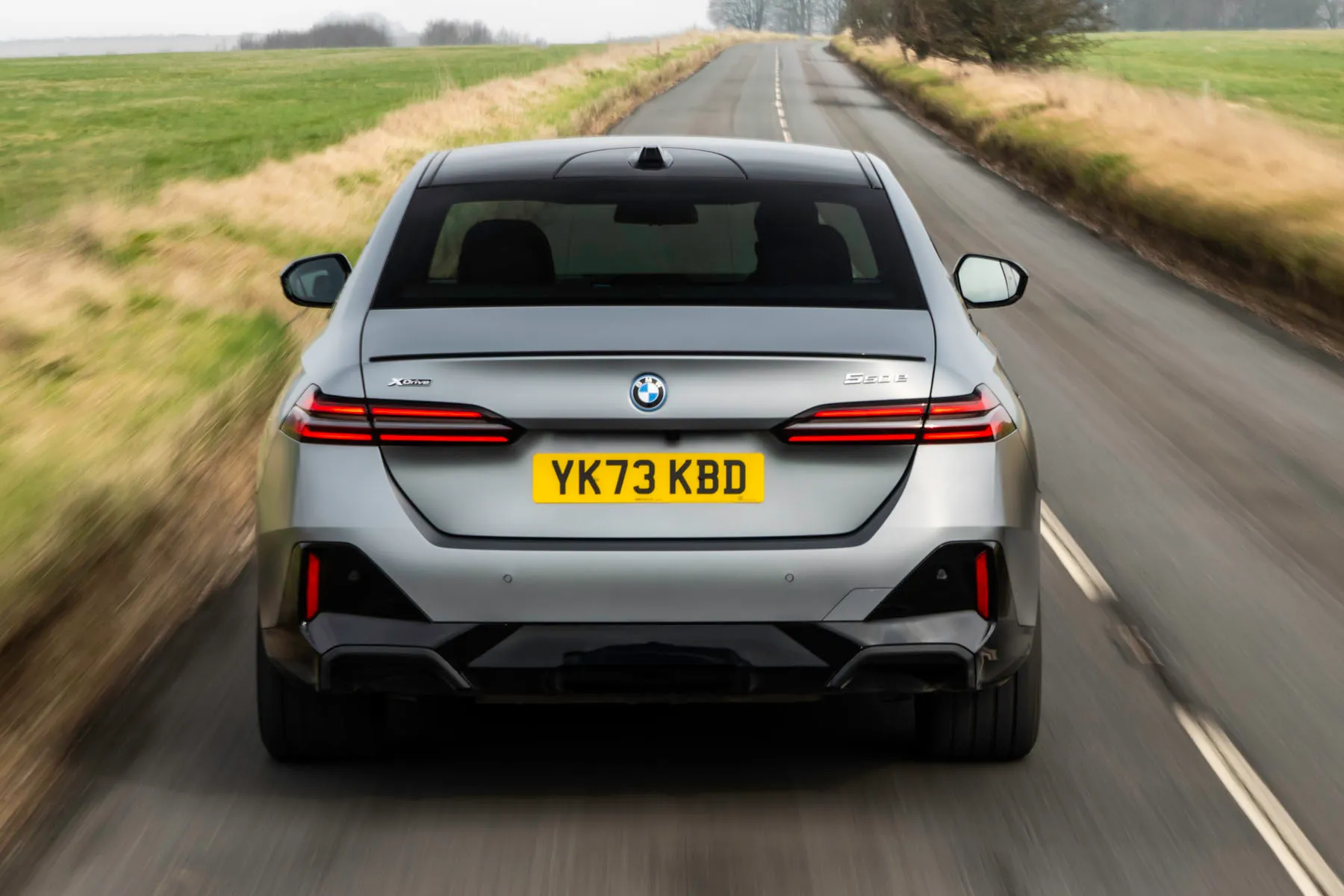
So far, we’ve only had the chance to drive the range-topping version of the petrol-powered 5 Series, the 550e plug-in hybrid. While the other versions have a passive M Sport suspension as standard, the 550e version comes as standard with BMW’s Adaptive Suspension Professional: this can be added to the other versions at an additional cost. As such, we can’t comment on how the 5 Series behaves without the adaptive setup fitted, but we can tell you that with it, the 5 Series is superb.
Like most such systems, selecting one of the sportier driving modes adds a bit of extra stiffness to the suspension, which is designed to deliver sharper control over body movements and a greater feel of connection with the road. And the difference between the modes is appreciable. But the truth is that whatever mode you select, the adaptive suspension delivers a wonderful balance of comfort and sharpness. There’s enough forgiveness to deal with lumps and bumps in a fuss-free manner, while the car flows from bend to bend with precision and alacrity. You’re never under the illusion that you’re driving anything other than a big, heavy executive saloon, but given the size and weight of the car, it feels impressively agile. You don’t get that nose-heavy feel under braking that you get in most PHEVs, either.
The Adaptive Suspension Professional fitted to the 550e also comes with Integral Active Steering included. This turns the rear wheels in the opposite direction to the fronts by a few degrees at low speeds to tighten up your turning circle, and in the same direction at high speeds to increase stability. Some drivers might wish for a tint bit more feel through the steering, but it’s wonderfully responsive and accurate, while also being beautifully weighted.
What engines and gearboxes are available in the BMW 5 Series?
Like we said a moment ago, we’ve only had the chance to drive the range-topping 550e so far, so we can’t yet tell you what the other engines feel like just yet, but nevertheless, we’ll do our best to give you the lowdown on them.
The range begins with the 520i, which uses a 2.0-litre, four-cylinder turbo petrol engine fitted with a 48-volt mild hybrid system. This combination delivers 208PS to the rear wheels via an eight-speed automatic gearbox, and this version of the 5 Series is capable of seeing off the 0-62mph dash in 7.5 seconds.
Next comes the 530e plug-in hybrid, which takes the 520i’s petrol engine and adds a beefier electric motor to deliver 299PS to the rear wheels. The 0-62mph sprint comes and goes in 6.8 seconds, and the car can run in electric-only mode at speeds of up to 87mph.
At the top of the range lies the version we have tried, the 550e plug-in hybrid. Like the 530e, this can run at up to 87mph in electric-only mode, but after that, it’s all-change. This version combines a 3.0-litre six-cylinder turbocharged petrol engine with additional electric propulsion to deliver a whopping 489PS to all four wheels.
Given the numbers involved, it’ll come as no surprise that the 550e is devastatingly fast. The official 0-62mph figure is a very impressive 4.3 seconds, but whether you’re getting away from the mark of picking up the pace on the move, any meaningful interaction with the accelerator pedal results in a sensationally strong surge of forward motion.
Refinement and noise levels
The 550e is fast, then, but perhaps what’s more remarkable about it is the smoothness of the powertrain. The petrol engine sounds fabulous when you give it a beautiful of revs, but when you don’t, it stays wonderfully quiet and subdued, while the electric assistance cuts in and out so smoothly that, most of the time, you have absolutely no idea which of the various power sources the car is running on. Excellent suppression of wind- and road noise make your progress even more serene and relaxed, and at a steady motorway cruise, the car is whisper-quiet.
We expect wind- and road nose to be just as well suppressed in the other versions, but right now, we obviously can’t vouch for the refinement of the other powertrains.
As far as we’ve experienced, the only thing that spoils the calm in the 5 Series is of BMW’s own making. The ‘IconicSounds’ function is a series of synthetic wooshing and wailing noises that are designed to make your driving experience more theatrical and dramatic. For every person that finds it dramatic, there’ll be another that finds it hugely annoying. Thankfully, it can be turned off fairly easily.
Safety equipment: How safe is the BMW 5 Series?
The 5 Series was crash-tested by Euro NCAP upon its release in 2023, meaning it was tested under some of the most stringent standards to date. It’s tremendous news, then, that it was awarded the full five-star rating, with an 89% score for adult occupant protection, 85% for child occupant protection, 86% for the protection of vulnerable road users and a 78% safety assist score.
The 5 Series comes with standard safety equipment including automatic emergency braking, lane departure warning and correction, seven airbags, adaptive LED headlights with high beam assist, dynamic stability control, cornering brake assist, a brake drying function, trailer stability control, rear cross traffic alert and braking, adaptive cruise control, manual speed limit assist.
More kit can be had with the Driving Assistant Professional, which comes as part of the Tech Pack Plus. This gives proper stop-and-go functionality for the adaptive cruise control, along with enhanced steering and lane control. The pack also includes the ability to park your car using your smartphone.
MPG and fuel costs: What does a BMW 5 Series cost to run?
"Nobody would expect a BMW 5 Series to be a cheap car to buy or to insure, but efficient powertrains mean it can be a cheap car to run, provided you use it in the right way."
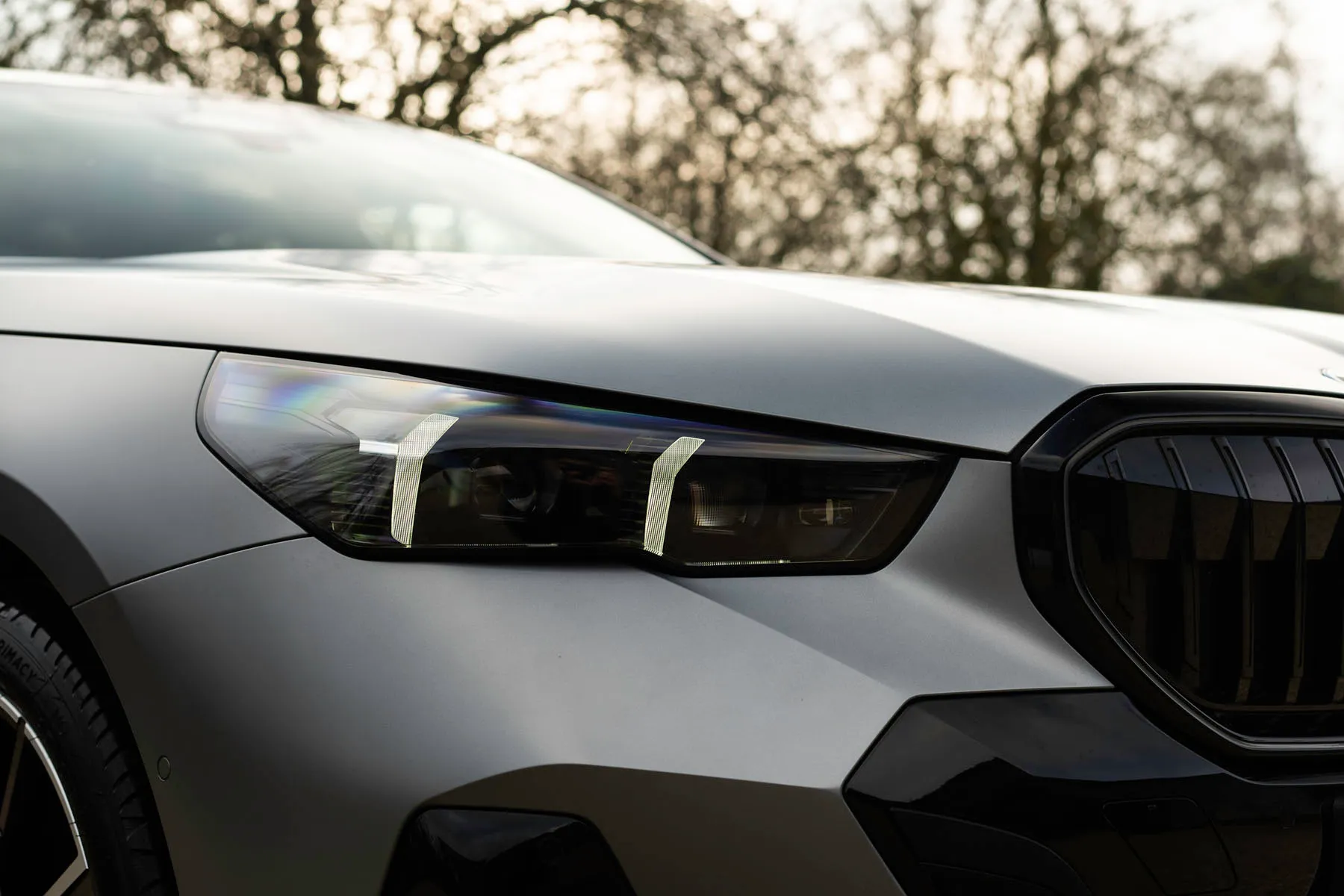
As we’ve observed, the 520i comes with mild hybrid technology to give a small boat to both the car’s performance and its fuel economy. And sure enough, its official WLTP fuel economy figure of up to 49.6mpg is pretty impressive given the car’s size.
According to the official WLTP figure, the plug-in hybrid versions do a lot better. On the testing regime’s combined cycle, the 530e achieved a figure of up to 470.8mpg, helped in no small part by the car’s all-electric range of up to 63 miles. The 550e wasn't all that far behind, either, with its electric range of up to 55 miles helping it to an official combined figure of up to 353.1mpg.
We’ve said it before and we’ll say it again, however, that the official tests are unrealistically flattering to plug-in hybrids, and the fuel consumption you get in the real world will depend entirely on how you use them. Keep your car charged up and limit yourself solely to short journeys that can be completed on electric power alone, and you won’t use a drop of petrol. Fail to do so, and make use of the petrol engine on a regular basis, and you’ll use absolutely loads due to the extra weight of the batteries in your car.
How reliable is a BMW 5 Series?
The latest eighth-generation BMW 5 Series is built using all-new technology, and was only introduced in 2023, so there hasn’t been enough time to ascertain whether any regular reliability issues have come to light.
However, BMW’s performance in the most recent HonestJohn.co.uk Satisfaction Index - which considers reliability alongside several other areas of general customer satisfaction - should provide buyers with some peace of mind. The German brand placed in 12th position out of 29 carmakers considered, putting it ahead of the industry average and in front of bitter rivals such as Audi and Mercedes-Benz. Like all of BMW’s cars, the 5 Series comes with a three-year, unlimited-mileage warranty.
Insurance groups and costs
Go for the 520i, and your car will sit in insurance group 35 regardless of which trim you choose. Opt for the 530e, and the M Sport sits in group 39 while the M Sport Pro is subject to a group 40 premium. The 550e, meanwhile, is a group 44 car. Considering that insurance groupings work on a scale of 1-50, and the higher the number, the more expensive it’ll be to insure, then all 5 Series buyers can expect fairly high premiums.
VED car tax: What is the annual road tax on a BMW 5 Series?
There’s good news and bad news on this score. Because the 520i has plug-in hybrid tech, and both the 530e and 550e are plug-in hybrids, all versions qualify for the alternative-fuel discount on your annual VED tax bill. The bad news is that this discount amounts to merely a tenner, so you’re still left with £170 to pay.
The even-worse news is that because all versions cost over £40,000, all of them get clobbered by the exchequer’s luxury car surcharge. This means that you’ll be hit with an additional £390 charge (taking the total to £560) for a five-year period between years two and six of the car’s life, after which point your annual payments will revert to the basic rate.
There’s better news if you’re a company car driver. You’ll want to avoid the 520i like the plague as you’ll pay Benefit-in-kind tax of at least 31% of its value, making monthly tax bills ruinously expensive. Go for one of the PHEVs, however, and your monthly bills will be calculated using just 8% of your car’s value, making them much, much more palatable.
How much should you be paying for a used BMW 5 Series?
"A BMW 5 Series is never going to be a cheap car, but it looks like decent value next to rivals. It’ll be a while before the used car market has examples in abundance, though."
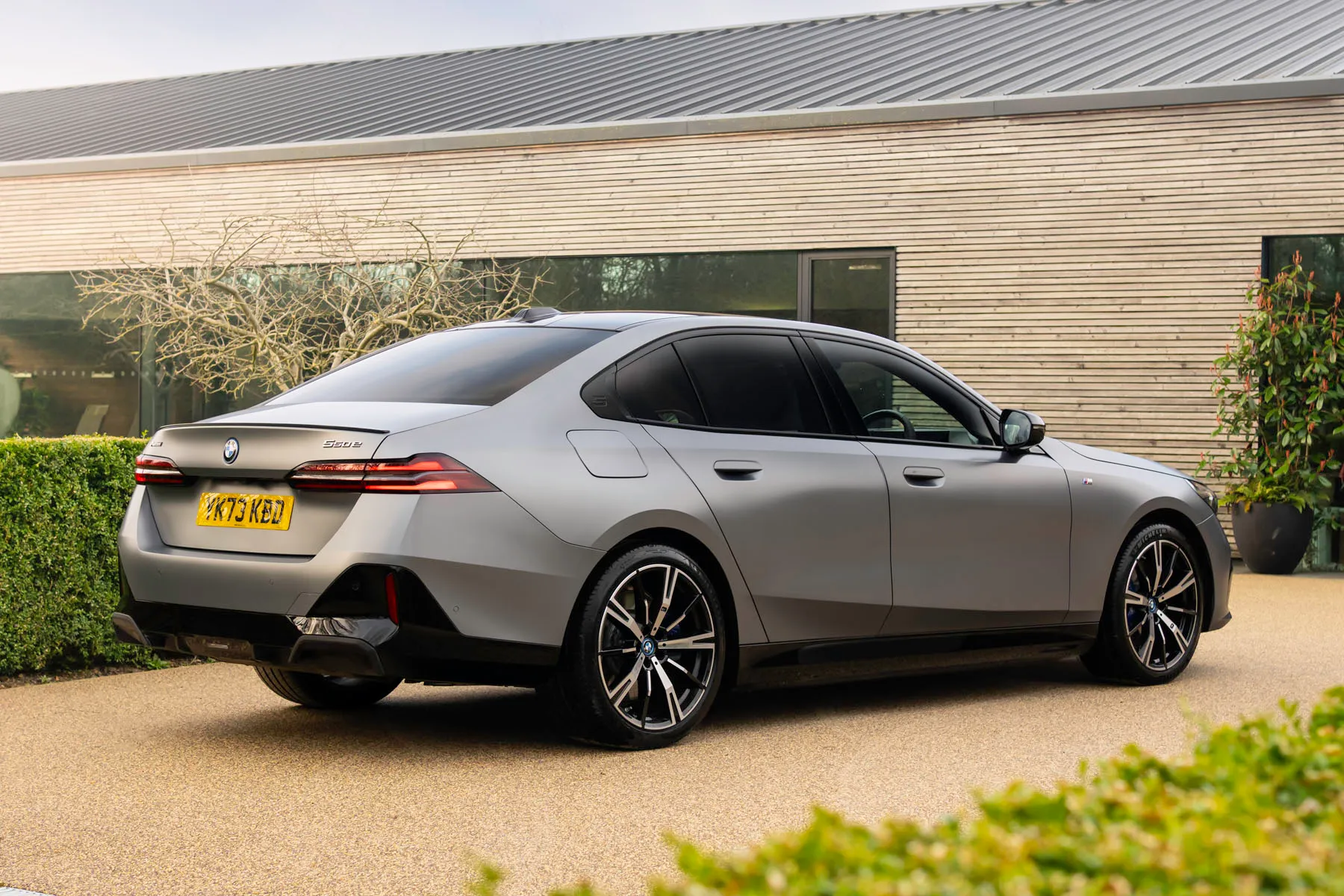
If you’re buying brand new, the BMW 5 Series range starts at around £51,000 for the 520i M Sport, rising to £54,000 for the M Sport Pro version. Choosing the 530e plug-in hybrid will hike your starting price to £60,000, with the same premium required to get you into the M Sport Pro, while the more powerful 550e plug-in hybrid will cost you around £77,000 as a minimum.
Since the eighth-generation 5 Series was only released in 2023, there hasn’t yet been time for many pre-owned examples to find their way onto the used market. It’s always worth looking out for pre-registered examples at dealers, though. These are cars that have been registered by the dealer before being sold in order to meet sales targets, and rooting out one of these can get you an as-new car with nothing more than delivery mileage under the wheels for a very useful four-figure discount.
Trim levels and standard equipment
On top of all the infotainment and safety equipment we’ve already talked about, the 5 Series comes as standard with a decent amount of luxury gear. M Sport is the entry-level trim, and this comes with 19-inch alloy, dual-zone climate control, the Interaction Bar, heated front sports seats, imitation leather and suede upholstery, a leather steering wheel, digital key, power folding door mirrors and a parking assistant that includes front- and rear sensors and a reversing camera.
M Sport Pro trim adds 20-inch alloys and various exterior styling elements, including illumination of your trademark kidney grilles. However, considering the M Sport Pro costs you an extra three grand on top of the regular M Sport, that’s not an awful lot for your money.
As ever with a BMW, you can go bananas with all manner of options and option packs, and that’ll send the price of your car soaring as quick as a flash.
Ask the heycar experts: common questions
What is the BMW 5 Series?
Is the BMW 5 Series an executive car?
Is the BMW 5 Series a good car?
Get our latest advice, news and offers
Keep me updated by email with the latest advice, news and offers from heycar.
By submitting you agree to our privacy policy
